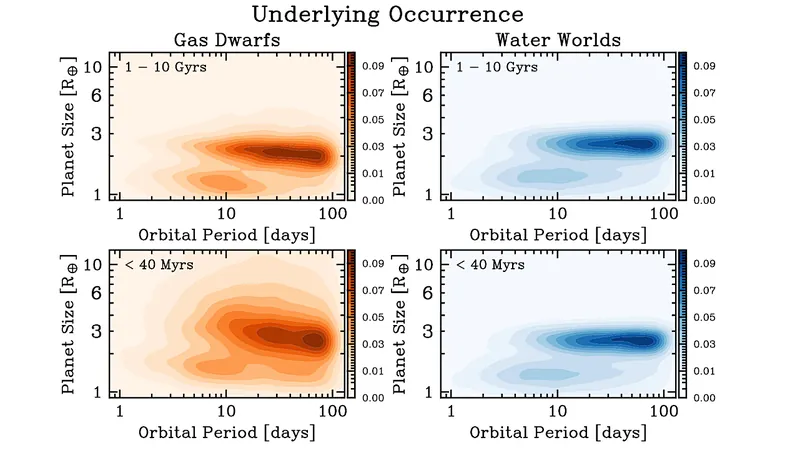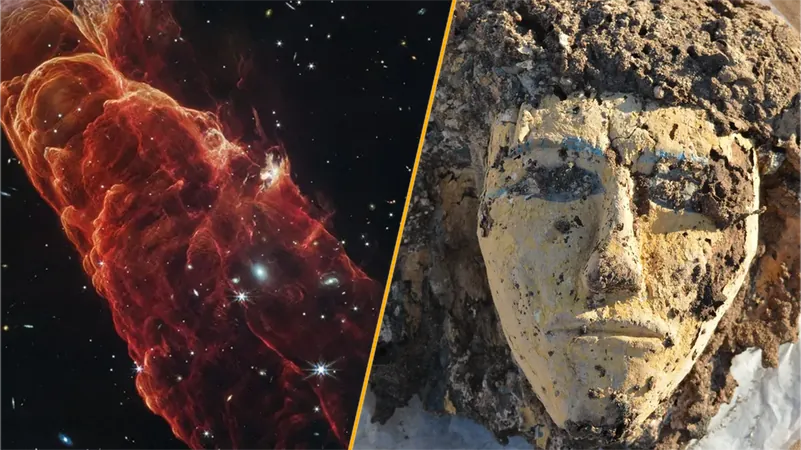
Unraveling the Mysteries of Gas Dwarfs and Water Worlds in Young Exoplanets
2025-03-25
Author: Arjun
Introduction
The detection of young transiting exoplanets marks a groundbreaking advancement in our comprehension of planet formation and evolution. As astronomers continue to explore the cosmos, a pivotal question emerges: how do we differentiate between 'gas dwarfs' and 'water worlds'?
Formation Hypotheses
Recent observations of close-in sub-Neptunes—planets orbiting close to their stars—suggest two main hypotheses for their formation: the gas dwarf hypothesis and the water world hypothesis. Both models explain the observed masses and radii of these planets at approximately 1 billion years (Gyr) of age, but they follow distinct pathways.
Key Distinctions
One of the key factors in distinguishing between these two types of planets lies in their size during their early formation stages, particularly around 100 million years (Myrs). It has been determined that the bulk mean molecular weight within the atmosphere of a sub-Neptune plays a crucial role. Gas dwarf envelopes are expected to have a lower mean molecular weight in comparison to water worlds, which leads to significant differences in size as these planets age.
Population Models and Evidence
To further this investigation, researchers have constructed population models based on the two hypotheses, successfully replicating the demographics observed from the Kepler space mission within the age range of about 1 to 10 Gyrs. Notably, there is growing evidence suggesting that the gas dwarf model aligns more closely with the limited sample of young exoplanets—those under 40 Myrs—identified by the Transiting Exoplanet Survey Satellite (TESS).
Size Independence
Interestingly, the radius of these young, puffy sub-Neptunes appears to be largely independent of their mass, indicating that accurately determining mass might not be essential to understanding the influences of mean molecular weight on the population level.
Mixed-Envelope Scenarios
The study also confirms that the predicted divergence in size between gas dwarfs and water worlds holds true even in mixed-envelope scenarios, wherein planetary atmospheres consist of combinations of hydrogen and steam. This finding underscores the importance of targeting the youngest observable stellar clusters in transit surveys, as they offer a unique opportunity to measure and leverage the dynamics of mean molecular weight among these nascent worlds.
Conclusion
As we aim to further dissect this fascinating radius valley—from distinguishing gas dwarfs from water worlds—the implications could reshape our understanding of planetary formation and the diversity of planetary systems in our universe. Stay tuned for what may be the next great leap in astronomical discovery!



 Brasil (PT)
Brasil (PT)
 Canada (EN)
Canada (EN)
 Chile (ES)
Chile (ES)
 Česko (CS)
Česko (CS)
 대한민국 (KO)
대한민국 (KO)
 España (ES)
España (ES)
 France (FR)
France (FR)
 Hong Kong (EN)
Hong Kong (EN)
 Italia (IT)
Italia (IT)
 日本 (JA)
日本 (JA)
 Magyarország (HU)
Magyarország (HU)
 Norge (NO)
Norge (NO)
 Polska (PL)
Polska (PL)
 Schweiz (DE)
Schweiz (DE)
 Singapore (EN)
Singapore (EN)
 Sverige (SV)
Sverige (SV)
 Suomi (FI)
Suomi (FI)
 Türkiye (TR)
Türkiye (TR)
 الإمارات العربية المتحدة (AR)
الإمارات العربية المتحدة (AR)